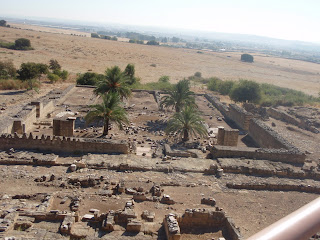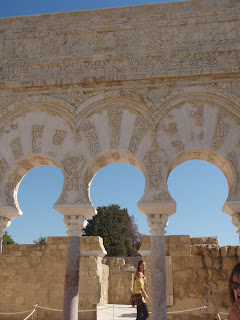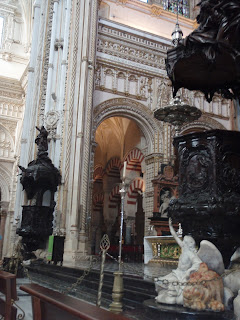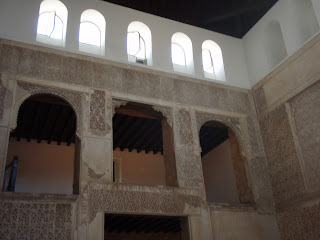Quick History Lesson (feel free to skip it and just look at the pictures): The Prophet Muhammad died without giving instructions on how to choose successors, and skipping over a lot, eventually it was too hard to keep the political power of the Caliphate in one location. Abd ar-Rahman III, who was descended the earlier Ummayad dynasty, declared himself Caliph of Córdoba in 929. He was the third, with the existance of the Fatimid and Abbasid caliphs, in Cairo and Bagdad respectively, all claiming to be the one legitimate power. Abd ar-Rahman III needed to demonstrate that he was the true successor of Muhammad, and also wanted to show off his new power and status, he built Madinat al-Zahra. The city was a place for the royals and the army, and had to have all kinds of ways to protect himself because people were trying to kill him all the time.
Ruins
Arches. They found the pieces but a lot of them were missing, but they decided that they would put it back up if they could figure out how it looked. So that's why some of it looks new.
Parts of the decorative patterns that covered the outside of the buildings. There are SO many of these pieces, and they all get cataloged and then they try to place them. Still a lot of work to be done.
Medieval Pizza Oven
The Friday Mosque for the complex. Easy to identify because all the other buildings are oriented in the same direction, and this one is turned to the east.
This is called the house of Ya'far. Ya'far was a slave, and a eunuch, who was able to become very powerful partly because he was very smart, and possibly because he was, as my art history teacher put it "a very, very special friend" of the second Caliph of Córdoba, Al- Hakum II.
This is a swimming pool in front of the throne room that they are working on restoring. A lot of the knowledge about the palace and the complex comes from the writings of travelers, and one traveler recorded an incident where Ya'far, upon seeing an old man in the pool, said something like "Don't drown old man." The traveler wrote that the man answered him "Don't worry, I can float because I still have my balls." Besides being a funny story, it is interesting to think about how stories like that tell you more information than just the story, as now we know that people swam in this pool.
Unfortunately, the throne room was closed while we were there.
After finishing at Madinat al-Zahra, we went into the center of Córdoba.
Calleja de las Flores, with the Great Mosque in the background. This is a popular postcard picture, and I guess the people who lived here started keeping the flowers like this, but now that it is such an iconic spot, the city takes care of them now.
Inside the Great Mosque, which was started by Abd ar-Rahman I in 784, and improved on by his family line. This includes construction ordered by Abd ar-Rahman III, and Al- Hakum II. In this way, parts of the Great Mosque were build at the same time as the Madinat al-Zahra.
The Mihrab, which is the place where everyone focus their attention during prayers. The Mihrab is surrounded by passages from the Qur'ran, and is very richly decorated.
When Córdoba fell in 1236, the Catholic monarchs turned the mosque into a church, and added a Renaissance Cathedral right in the center. This picture looks across the space, and you can see the elements of the mosque that continue on the other side. Charles V gave the permission for this change, but it is said that after seeing the construction, he regretted allowing the building to be altered, however it is possible that without the change, the entire structure would have been destroyed.
One interesting opportunity that comes from having these two styles contrasted so closely, is that it is easy to look at how the Muslim and Christian religions saw their places of worship as manifestations of God.
The Mosque in Islam is the house of the community, and as all people are supposed to be equal before Allah, the space for worship tends to be uniform, full of repeating elements, and would inspire a sense of community for the faithful who have come to pray. A Cathedral on the other hand is build to be the house of God, and the high ceilings, high lights, and the decoration is all designed to make those in the church feel a sense of awe, or to feel small in the presence of the divinity.
After the tour of the Great Mosque, we went to see the last surviving medieval synagogue in Andalusia, and also to hear some traditional music, which was very beautiful, and so soothing that I think I feel asleep.
It was a very small space, likely private, or just for a family. The upper room would have been for the women. This was eventually hidden behind plaster, as even having a piece of paper with Hebrew written on it was crime, it would have certainly been incriminating to have been found with a synagogue in your home.
Well, that's Córdoba. This coming week will be a busy one, five days of class compared to my usual four, and my birthday this weekend.
Bye for now.















No comments:
Post a Comment